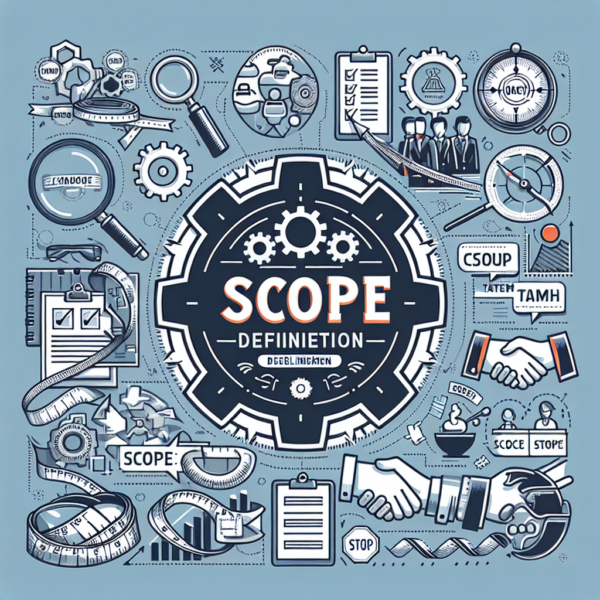The project scope is a concept that lies at the heart of any successful project. It involves defining the objectives, deliverables, features, functions, tasks, deadlines, and costs of a project. Beyond just spelling out these specifics, the project scope establishes a boundary for the magnitude of work to be done in the project, and it gives direction to all project-related activities. Furthermore, understanding and accurately outlining the project scope provides a roadmap, which helps guide the project team as they handle challenges and strive for a successful project completion.
The role of project scope in successful project management is paramount. It forms the backbone of the project and serves as a reference point throughout the project’s lifecycle. Without a well-defined scope, a project can quickly sink into chaos, as there will be no clear objectives to guide or benchmarks to measure the progress. A correctly defined scope ensures that all team members are on the same page, preventing misunderstandings that could potentially derail the project.
In this comprehensive guide, we will discuss everything you need to understand about defining and managing project scope. Throughout this article, we will provide a detailed explanation of project scope, its vital connection with project success, the essential steps involved in defining project scope, and how to manage it effectively. We will also focus on the importance and role of project management tools in scope management. By the end of this article, you will have a solid understanding of what is meant by project scope management and how to implement it successfully in your projects.
Understanding Project Scope
Understanding the project scope is integral to the success of any venture. It is essentially a detailed set of all the project goals, tasks, resources, budgets, and deliverables. These are officially documented in the project scope statement. This is not just a simple list, but rather a well-defined representation of the project’s objectives and the steps needed to meet these goals. It serves as a guide that provides direction to all stakeholders involved in the project.
The role that project scope plays in project management is crucial. It functions as a reference point, keeping everyone aligned and accountable. The scope clarifies what is expected, what will be delivered, who is responsible for what, and what the timelines are. With a clearly defined project scope, managers can efficiently allocate resources, devise timelines, and measure project progress against the benchmark set in the scope.
However, the project scope is not only a tool for organization. It is also intimately tied with the success of the project. The scope sets the boundaries for the project, indicating what is included and what isn’t. If the project scope is not properly defined, it can result in wasted effort, time, and resources which can lead to project failure. Moreover, a clear project scope promotes transparency, establishes credibility with stakeholders, and aids in avoiding scope creep—the expansion of project scope once the project is underway, without the adjustment of resources, timelines, and budget.
In other words, a well-defined project scope is incredibly influential in the overall direction of any project. It sets the pace and directs the focus of the project team, and ensures that the project remains on track, successfully achieving its objectives while keeping stakeholders informed and engaged. This importance is why project scope deserves thorough understanding and careful management.
How to Define Project Scope
To successfully define a project scope, the first step involves understanding in depth what the project entails. This requires gathering necessary information, including the project goals, deliverables, deadlines, and resources. It’s at this stage where you set expectations, recognize potential opportunities, and identify any potential risks that may arise. Understanding your project in depth and from multiple perspectives is the cornerstone for crafting a realistic project scope.
The involvement of stakeholders in defining the project scope is crucial. Stakeholders are included in initial discussions, not just to keep them informed but to actively involve them in decision-making. They provide valuable inputs, as they are closely linked to the outcomes. Their involvement helps in acknowledging the project’s potential impact on different parties involved and assists in setting achievable targets. Hence, stakeholder engagement enhances the accuracy and completeness of the project scope.
Defining the constraints and assumptions is an equally significant part of setting the project scope. Constraints are specific limitations, like budget or time, that are imposed on the project. While assumptions lay down the groundwork for planning and development, they may include aspects like the availability of certain resources, technological factors, or even input from stakeholders. It is important to identify and document these aspects since they directly impact the project.
Finally, write a project scope statement, a formal document that outlines the project plan in its entirety. It includes your project’s goals, deliverables, timeline, and resources. Moreover, it also details the project limitations or constraints, as well as the critical assumptions made during the planning stage. This serves as a written agreement among all the parties involved, clearing up any ambiguities, and setting the tone for effective communication throughout the project lifecycle. A clear, well-defined project scope statement ensures that everyone is on the same page, avoiding disputes or misunderstandings down the line.
Managing Project Scope
Effective project scope management is crucial to any project’s successful completion. This step involves careful management of the project scope that has been previously defined. Project scope management assists project managers in ensuring that all tasks are on track and are progressing as planned. It helps maintain team member focus on shared goals and aids in averting scope creep or gold plating, either of which can result in project failure.
Creating a scope baseline is an essential part of project scope management. Once the project’s scope has been defined and documented, this documentation is referred to as a “scope baseline”. The benefits of a scope baseline are numerous, most notably it acts as a reference point throughout the project. Any changes or variations in the project tasks are measured against this baseline. It functions as a yardstick, aiding the team in determining whether they are moving in the desired direction.
To manage and control the project scope effectively, certain steps must be executed diligently. This includes regular project scope audits, establishing change control processes, continuous monitoring, and redefining scope if necessary. All changes in scope should be closely monitored and controlled to prevent negative impacts on the project. Managing and controlling the scope also involves detailed communication with all stakeholders, ensuring that everyone is aligned.
Addressing scope creep and preventing it is one of the biggest challenges in scope management. Scope creep refers to uncontrolled changes or continuous growth in a project’s scope, which often occur when the scope of a project has not been accurately defined, documented, or controlled. It can affect the cost, time, and resources of the project, potentially leading to project failure. Therefore, it is vital to understand project scope management thoroughly, continually keep team members and stakeholders informed about scope changes, and ensure a clear comprehension of what a change involves before approval.
The Role of Project Management Tools in Scope Management
The role and impact of project management tools in defining and managing project scope cannot be overstated. They not only streamline and automate various project scope processes but also play a vital part in ensuring effective project scope management. Tools essentially provide a comprehensive view of the project’s progress and how closely it aligns with the initially defined project scope.
A wide array of project management tools are available on the market, each boasting distinct features intended for effective project scope management. Some popular tools include, but are not limited to, Microsoft Project, Jira, Trello, and Asana. These tools help in creating a scope baseline, tracking project progress, identifying scope creep, and managing it effectively. Key features to look for in these tools include task assignment and tracking, progress monitoring, report generation, and clear visualization of project scope and status.
However, remember that tools alone cannot guarantee success. It’s crucial to choose the right tool that best fits your project’s requirements and your team’s workflow. To start, understand your project’s needs and what you expect from a project management tool. Consider factors such as ease of use, scalability, integration with other tools, customer support, cost, and actual user reviews when selecting a tool.
Additionally, a company’s organizational structure, workflow, and project management methodology can greatly influence the selection of a project management tool. An agile environment may benefit from a tool that offers flexibility and real-time updates. A more traditional project management approach might require a tool with strong scheduling and budgeting features. Therefore, selecting the right project management tool is as crucial as defining and managing the project scope itself.
Conclusion
To recap this comprehensive guide, defining and managing the project scope enables project managers and stakeholders to establish shared expectations. By thoroughly defining the project scope, we can provide a baseline against which performance can be measured and project success can be evaluated. It is a tool, and a mindset, that keeps everything on track. It helps in setting priorities and aligning stakeholders to the same objectives, ensuring that everyone is working toward the same ultimate goal and understanding of that goal.
Project scope, apart from being a vital part of project success, also acts as a guard against scope creep. A well-defined project scope can eliminate ambiguities, misunderstandings, and friction among team members and stakeholders. More importantly, it helps keep the project focused, aligned to the objectives, and within budget and time constraints. In essence, the project scope is the binding glue that holds the project and all its elements together, guiding it to completion.
As we wrap up this discussion, imagine how it would feel to lead a project where everyone understands and agrees with the project deliverables, understands their roles and responsibilities, is aware of the allowances and constraints, and most importantly, is working toward the same vision. We hope that this guide has equipped you with the knowledge and strategies you need to accurately define and manage project scope in your upcoming projects.
In conclusion, as you venture into your next project, recognize that the significance of project scope goes far beyond its definition; it is the lifeblood of successful project delivery. The benefits of defining and effectively managing project scope clearly stand out. Consider it not just as a task to tick off your checklist but as a crucial step in determining the success of your project. We encourage you to fully embrace its potential in guiding your project to completion efficiently and with a clearly defined path.






